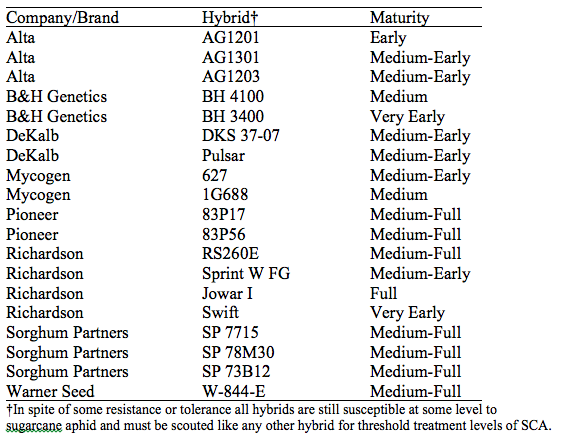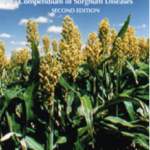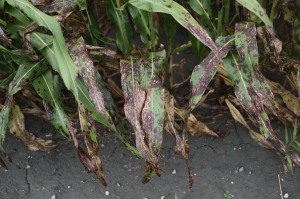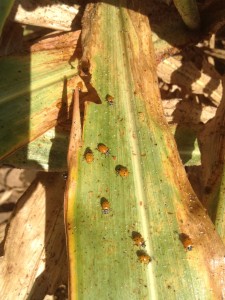Evaluating if Grain Sorghum Hybrids with Seed Company Designation of Tolerance/Resistance to Sugarcane Aphid Are Right for You in 2016
This tip was provided by:
Calvin Trostle, Extension Agronomy, Lubbock, 806-746-6101, ctrostle@ag.tamu.edu
Ron Schnell, State Cropping Systems Specialist, College Station, (979) 845-2935, ronschnell@tamu.edu
Statewide
Evaluating if Grain Sorghum Hybrids with Seed Company Designation of Tolerance/Resistance to Sugarcane Aphid Are Right for You in 2016
(Trostle)
In our last Sorghum Tip we published a list of 19 hybrids that companies have designated as what they believe are there most likely tolerant/resistant hybrids to sugarcane aphid. Since then, as a Texas A&M AgriLife Extension staffer, I recognize that we in AgriLife don’t have enough information (or any in several cases) to publish about these hybrids’ tolerance/resistance and SCA. Thus as a needed Disclaimer on the AgriLife December Sorghum Tip, though AgriLife staff have contributed to information (hybrid trial data, aphid and damage ratings, field observations) to the information Dr. Bean, USCP compiled, we in AgriLife have not verified the company information as well as other sources ourselves, and we have no AgriLife data of any kind on about half of these hybrids.
As an alternative I have written an article with the above title that discusses how you the producer may evaluate whether one of the 19 grain sorghum hybrids noted above is right for you. Read the full edition at http://lubbock.tamu.edu (posted title is “Grain Sorghum Hybrid Selection and Sugarcane Aphid 2016).
As a sampling of the document’s advice, here are five questions you can ask your grain sorghum seed dealer:
1) “What hybrid(s) do you have with a proven SCA resistance gene in its parentage?”
2) “If you do, does that genetic background transfer actual hybrid resistance to SCA in the field?”
3) “What field evidence do you have for this hybrid’s substantial tolerance/resistance? Seedling tests? Field observations? Field insect counts? Yield data?”
4) “Is at least some of your field data from independent or external sources?” (If so, who?)
5) “How does the yield of your current SCA tolerant/resistant hybrid(s) compare to your company’s best grain sorghum hybrids?” (Agronomically, you want to understand the grain yield potential of good grain sorghum hybrids even if susceptible to SCA vs. tolerant/resistant hybrids. If there are significant yield differences be sure to ask/understand if those differences may be due to likely lower-yielding shorter maturity in a hybrid.)
The list of 19 sorghum hybrids noted above that have stronger claims about SCA tolerance/resistance will be maintained by United Sorghum Checkoff Program, http://sorghumcheckoff.com/pest-management/, and it may change with additions and deletions.
Texas A&M AgriLife Grain Sorghum Yield Data & Sugarcane Aphid Tolerance/Resistance
(Schnell)
Planting resistant or tolerant hybrids will be vital for long-term management of sugarcane aphid in sorghum. As noted previously, USCP has provided a list of grain sorghum hybrids that are believed to have some level of tolerance to sugarcane aphids. However, identifying well-adapted hybrids with consistent yield performance in your region will remain the most important criteria for hybrid selection. You should not sacrifice significant yield potential to plant resistant or tolerant hybrids. There is no guarantee significant pest pressure will materialize and no guarantee that treatment for sugarcane aphid will be avoided.
The Soil & Crop Sciences Department’s Crop Testing Program collects information on grain sorghum hybrid performance from more than a dozen locations across Texas each year. Results can be found at: http://varietytesting.tamu.edu/grainsorghum/. In addition, hybrids identified as having unspecified levels of tolerance to sugarcane aphids will be summarized along with several susceptible public checks. These results will be available at the website above by the end of the week of January 18th. Again, consistent yield performance will be the most important criteria when selecting hybrids. Hybrids that perform well across multiple locations (regional summaries) and years (2- & 3-year summaries) should be strongly considered. Make sure to select a hybrid that has a maturity rating appropriate for your environment. Several early to medium-early hybrids listed in the USCP report may be appropriate in certain situations (dryland and later plantings in west or south Texas).
Which Grain Sorghum Hybrids have Significant Apparent Tolerance/Resistance to Sugarcane Aphid?
This tip was provided by:
Calvin Trostle, Extension Agronomy, Lubbock, 806-746-6101, ctrostle@ag.tamu.edu
Statewide
Which Grain Sorghum Hybrids have Significant Apparent Tolerance/Resistance to Sugarcane Aphid?
Dr. Brent Bean, agronomist, United Sorghum Checkoff Program (and formerly Texas A&M AgriLife Extension agronomist, Amarillo), has compiled an initial list of grain sorghum hybrids that appear to have significant tolerance/resistance to sugarcane aphid (SCA). Some other hybrids may have a lesser degree of tolerance, but those are not listed. Dr. Bean has visited across the Sorghum Belt with companies, state university staff, farmers, etc. to arrive at this list as of Dec. 17, 2015. Producers should consult the USCP website, www.sorghumcheckoff.com, for possible updates beginning in early January.
Before I say anything else about how to use this list or how it was derived, know this: All commercial grain sorghum hybrids, including these listed below, have at least some level of susceptibility (and most are highly susceptible) to sugarcane aphid. All hybrids must be scouted, and at this time the same treatment thresholds apply to these hybrids as any other. No commercial hybrid is immune to SCA. Some Texas farmers made the mistake of assuming too much about the early purported tolerant hybrids in 2015, and they failed to treat SCA in timely fashion, or even scout their fields regularly if at all.
*Please note the following list is in alphabetical order by company and the order is not associated with believed tolerance levels.
Understand the Potential Caveats of this Initial List of SCA-Resistant/Tolerant Hybrids
- Much of the above information is derived only from seedling tests conducted in a controlled setting in a growth chamber or greenhouse. Real life conditions in your field are not a guarantee that the hybrid will demonstrate the same level of tolerance/resistance.
- Several of the above hybrids also have documented favorable reactions to SCA in field conditions, and additionally, there may be numerous reports from producers, Extension staff, field scouts, and crop consultants noting an individual hybrid performed well relative to other neighboring hybrids, etc. Dr. Bean notes that in most cases these hybrids have exhibited the ability to withstand higher infestation populations of SCA while retaining their yield potential, or SCA has been shown to increase in number much slower than in susceptible hybrids.
- You may hear a producer or other agriculturalist disagree with a hybrid being included on the above list. Know that these hybrids probably can’t tolerate/resist heavy SCA infestations on their own. For example, Dekalb DKS 37-07 has numerous documented and anecdotal observations of reduced SCA activity (not sprayed as soon, sprayed once instead of twice relative to other hybrids, not sprayed at all), but an elevator manager told me Dec. 16 that he thought that 37-07 had the same level of problems as any susceptible hybrid.
- Visit with the seed company about the hybrids you are interested in. Ask them what evidence they have for the hybrid’s tolerance/resistance. Seedling tests? Field observations? Field data? Do they have new information on any other hybrids?
- Regardless of a hybrid’s tolerance/resistance to SCA it is still critical to chose a hybrid based on its local adaptability and other favorable characteristics.
In our next Sorghum Tip in January we will provide a link to a summary of yield data comparisons for the above hybrids vs. trial averages from the Texas A&M AgriLife Crop Testing Program’s sorghum hybrid performance tests. (Most of the individual trial reports are already posted at http://varietytesting.tamu.edu/sorghum )
Texas Plant Disease Diagnostic Lab (TPPDL) vs. Direct Assessment by Sorghum Disease Experts
In our last Sorghum Tip we noted the services of TPPDL. Dr. Isakeit noted that this service lab is in part oriented toward horticultural assessments. You may wish to call your regional Texas AgriLife disease specialist (contact info. in previous Tip) to inquire if you might submit samples directly to Drs. Isakeit (College Station), Odvody (Corpus Christi), or French (Amarillo).
Texas Plant Disease Diagnostic Lab (TPPDL)
This tip was provided by:
Calvin Trostle, Extension Agronomy, Lubbock, 806-746-6101, ctrostle@ag.tamu.edu
Statewide
Texas Plant Disease Diagnostic Lab (TPPDL)
A service of Texas A&M University’s Department of Plant Pathology
In the previous Sorghum Tip we discussed where producers, agronomists, and others can access not only pictures of various sorghum diseases but also an understanding of the biology of common diseases in grain sorghum and possible management strategies.
But sometimes pictures just won’t do. Or you need an accurate diagnosis.
Enter TPPDL! This Plant Path lab and its clientele services may be accessed through http://plantclinic.tamu.edu/ With the exception of sorghum ergot sample analysis for seed, all sorghum samples in need of diagnostics may be submitted by filling out form AG-1178 then submitting the sample to Texas A&M. Cost is $35 per sample (out-of-state samples pay a surcharge). Instructions are on page 2 of the form.
Texas A&M AgriLife Plant Pathologists for Grain Sorghum
Three primary staff for AgriLife are experts on grain sorghum diseases among their primary duties. These are:
- Dr. Tom Isakeit, AgriLife Extension, College Station, (979) 862-1340, t-isakeit@tamu.edu
- Dr. Gary Odvody, AgriLife Research, Corpus Christi, (361) 265-9201, g-odvody@tamu.edu
- Dr. Ron French, AgriLife Extension, Amarillo, (806) 677-5600, rdfrench@ag.tamu.edu
These pathologists can help you with any field, hybrid, or management issues you may be facing with regard to grain sorghum and plant health.
Pictures of Grain Sorghum Diseases–Resources
This tip was provided by:
Calvin Trostle, Extension Agronomy, Lubbock, 806-746-6101, ctrostle@ag.tamu.edu
Statewide
Pictures of Grain Sorghum Diseases–Resources
In the previous Sorghum Tip we discussed some unusual foliar disease symptoms (zonate leaf spot) in grain sorghum that were more prominent in much of Texas this year. If there is a field question I often rely on published pictures to understand what I might be looking at in grain sorghum for possible diseases (the same goes for nutrient deficiencies and herbicide injury symptoms). Where are resources for grain sorghum?
The dated (1985) but still relevant Texas A&M Sorghum Diseases Atlas at http://amarillo.tamu.edu/files/2010/11/SorghumDiseases.pdf is still useful though of course the pictures are grainy (other crop diseases and a few updates for grain sorghum, some with a High Plains emphasis, may be accessed at http://sickcrops.tamu.edu). A newer publication from Texas A&M Plant Pathology is not currently on the web (only the print descriptions of plant diseases, for sorghum see http://plantdiseasehandbook.tamu.edu/food-crops/cereal-crops/grain-sorghum/; we are looking at getting this publication back on the Web via extra-A&M links).
Kansas State recently published S125 “Diagnosing Sorghum Production Problems in Kansas” (2014) which also has its own series of pictures and descriptions of common sorghum diseases, http://www.bookstore.ksre.ksu.edu/pubs/S125.pdf
A Comprehensive Guide for Grain Sorghum Diseases and other Maladies
“Compendium of Sorghum Diseases (2nd Edition)”, 2000 is published by the American Pathological Society, and it is available for purchase by clicking here. Texas A&M AgriLife’s Dr. Odvody is a co-author. I often carry my copy with me in the truck during the summer. It has over 130 descriptions and photos of symptoms of numerous of sorghum diseases, plant nutrient deficiency symptoms, herbicide injury symptoms, and environmental injury. If you work with sorghum a lot, I recommend you get a copy.
Zonate Leaf Spot in Grain Sorghum—2015 Observations
This tip was provided by:
Dr. Gary Odvody, Plant Pathologist, Texas A&M AgriLife Research, Corpus Christi, 361-265-9201, godvody@ag.tamu.edu (compiled by Calvin Trostle)
Coastal Bend
Zonate Leaf Spot in Grain Sorghum—2015 Observations
Zonate leaf spot (ZLS) produces unusual leaf disease symptoms on grain sorghum. You may not notice it at low levels but if incidence is pronounced this fungal disease produces unique and strongly expressed leaf symptoms (Fig. 1). Zonate leaf spot (Gloeocercospora sorghi) was common on grain sorghum in the Texas Coastal Bend in 2015 due to season long wet conditions through about July 1 when rains abruptly ended. Under conditions conducive to zonate leaf spot, the disease often develops as multiple lesions per leaf which coalesce to eventually kill the leaf tip and most of the entire leaf (Fig. 1, 2).
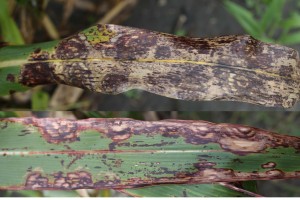
Fig. 2. Top Leaf: Multiple zonate lesions that have coalesced to kill most of the leaf blade, especially from mid-leaf to the tip. Bottom Leaf: Earlier leaf margin pattern of lesion development which may eventually coalesce across the leaf blade. (Gary Odvody).
As grain sorghum plants mature, leaves lose much of their resistance to pathogens so this disease can cause lots of foliar damage under disease-conducive conditions from mid to late season. However, ZLS typically does not cause economic loss of grain yield in Texas. Loss of leaves due to ZLS might affect forage yields in sorghum family forages although actual forage losses have not been documented. Under the multiple planting dates of 2015, sorghum maturing after July 1 in the lower coastal bend of Texas had progressively lower zonate leaf spot as drier, hotter conditions began to prevail.
Today’s grain sorghum hybrids and zonate leaf spot: Plant pathologists and sorghum breeders collaborate to eliminate sorghum lines and hybrids that are highly susceptible to foliar diseases including ZLS. This disease is present across South Texas in most years but generally at levels much lower than observed in 2015. The disease usually becomes most noticeable late in the season when the potential effect on yield is minimal. Except for avoiding highly susceptible hybrids there are no practical or necessary management strategies for ZLS on Texas sorghum.
For further information on this disease and additional photographs contact Dr. Odvody.
Albino Striping in Grain Sorghum Leaves—Glyphosate Drift?
This tip was provided by:
Calvin Trostle, Extension Agronomy, Lubbock, 806-746-6101, ctrostle@ag.tamu.edu
Statewide
Albino Striping in Grain Sorghum Leaves—Glyphosate Drift?
Herbicide drift is an issue in Texas cropping that sometimes we don’t want to talk about. I often find that producers don’t want to stir things up with neighbors and their herbicide applicators, be it land or by air, but the downside is that sometimes crops are indeed injured and yields drop. Lest anyone blame any particular crop, this is a two-way street. The sorghum producer is worried about glyphosate drift from the neighbor’s cotton field, but then cotton farmer is worried about sorghum’s possible use and mistakes in applying 2,4-D or dicamba, for which the cotton farmer’s crop can be injured. Introduce additional issues like conventional non-Roundup Ready cotton, high-value organic production (no chemical pesticides at all), and now the forthcoming dicamba and 2,4-D tolerant cottons, and drift issues can compound and become quite touchy.
In the Texas High Plains in 2014 due to some early rains and the broad distribution of Palmer ameranth species of pigweed, a lot of Roundup drift was observed onto grain sorghum. Early symptoms were often a nearly complete purple discoloration (Fig. 1) followed by various levels of tissue discoloration as some plants died (Fig. 2). Common to many of these seedlings is that secondary root growth from the base of the small crown was minimal to none (Fig. 3). These plants never recovered even with various foliar treatments with nutrients and growth regulators. The sooner they were replanted the better.
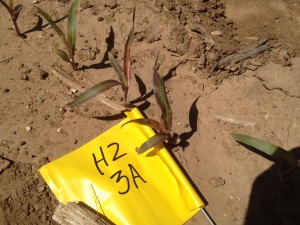
Fig. 1. Early purplish symptoms of glyphosate drift on seedling grain sorghum, Floyd Co., TX (2014).
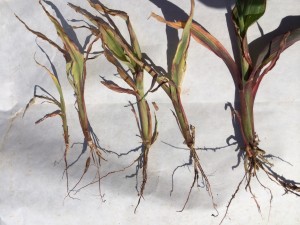
Fig. 2. Range of glyphosate drift symptoms on grain sorghum seedlings, Crosby Co., TX (2014). None of these plants would resume normal growth if they do survive.
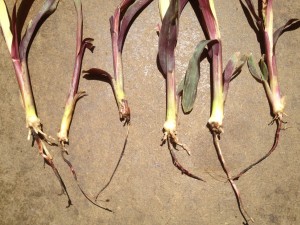
Fig. 3. Lack of secondary root development from the base of the crown due to glyphosate drift on grain sorghum seedlings, Hale Co., TX (2014). These seedlings would not recover.
Other plants might have exhibited light stunting, but overall survival was not in question. What did eventually show up a few weeks after the apparent glyphosate drift was albino or white striping on lower leaves, usually leaves 3 to 8, depending on the field and its growth stage at the time of drift (Fig. 4, Fig. 5). Dr. Wayne Keeling, Texas A&M AgriLife Research weed scientist, Lubbock, was able to reproduce these symptoms using dilute glyphosate in a hand spray bottle.
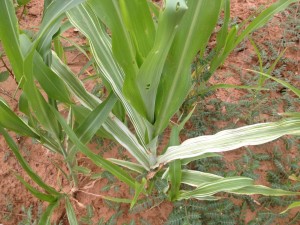
Fig. 4. Light glyphosate drift which led to eventual white striping symptoms on lower grain sorghum leaves, Hale Co., TX (2014). Plant withstood light drift without long-term injury and headed normally.
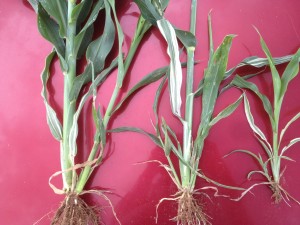
Fig. 5. Range of grain sorghum plant growth after receiving light injury from glyphosate drift (Lubbock Co., 2014). Left to right, plants demonstrated decreased ability to grow out of injury and head normally.
Similar drift symptoms of glyphosate injury on grain sorghum also appeared in the South Plains region in 2015. Some fields had spotty damage (Fig. 6) whereas others received enough drift to permanently stunt or kill most plants (Fig. 7).
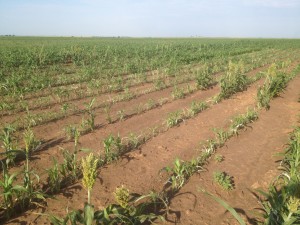
Fig. 6. Moderate to severe glyphosate drift from aerial application in sporadic pattern across a grain sorghum field, Lynn Co., TX (2015). Albino striping is evident on plants in center, and contrast of growth is observed from damaged vs. undamaged.
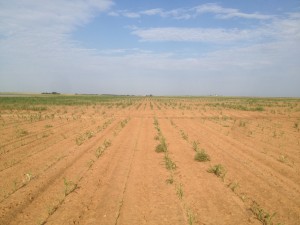
Fig. 7. Catastrophic glyphosate drift injury on grain sorghum from aerial application which occurred approximately ¾ mile away, Lynn Co., TX (2015).
Through many observations, particularly in 2014, it was interesting to see how often a barrier to drift might protect grain sorghum such as the rows of sorghum that received protection from 6-7’ tall corn plants (Fig. 8.). Fencerows, weeds (24” or taller), and even terrace ridges were enough to protect several rows of grain sorghum from significant injury.

Fig. 8. Several rows of grain sorghum protected by irrigated corn from apparent glyphosate drift from a southeast wind, Hale Co., TX (2014).
One producer has shared that the albino symptoms also can express in sorghum that was sprayed with glyphosate as a harvest aid. In this Rolling Plains example, the producer achieved a poor desiccation and kill with the glyphosate, and the plants regrew after harvest and stalks were baled. Albino symptoms were strongly evident on the regrowth (Fig. 9).
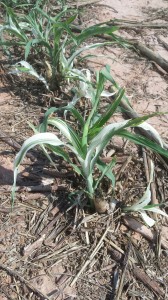
Fig. 9. Glyphosate harvest aid application to grain sorghum, August, 2015, Wilbarger Co., TX, resulted in poor desiccation and sorghum plants survived. After stalks were cut and baled for hay, sorghum regrowth in September demonstrated significant white leaf striping from residual in-plant glyphosate effects.
Much of the problems we have observed in the High Plains probably also occur in grain sorghum at some level in other Texas regions. Communication with neighbors before spraying—then holding people accountable if drift injury occurs—will help ensure needed safety and caution to minimize future drift injury potential.
Are there other possible factors that cause white sorghum?
Yes. Dr. Tom Isakeit, AgriLife Extension plant pathologist, College Station, notes that sorghum downy mildew is known to produce similar albino striping in leaves. There are four potential downy mildew inducing pathogens (one causes ‘crazy top’), but only Peronosclerospora sorghi in more advanced stages leads to white interveinal (between the veins) striping of the leaves (Fig. 10). This disease more likely develops under cool, humid weather and initial symptoms are a surface white powder on the leaves (mildew), but later stages of disease development lead to emerging leaves exhibiting parallel green and white stripes. The white tissue eventually becomes black (dies) and shreds.
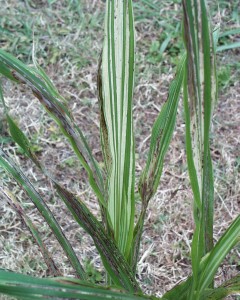
Fig. 10. Sorghum downy mildew and white striping in grain sorghum. Some white tissue is dying (now black, speckled). (File photo courtesy Dr. Tom Isakeit, AgriLife Extension plant pathology, College Station, TX.)
Also, clomazone herbicide (common brand is Command) may cause some striping in rotational crops like grain sorghum if residues remain after the 9-month rotation restriction. This herbicide has been used in cotton, rice, sugarcane, soybeans, and some beans, peas and vegetables in the past, but Dr. Keeling is aware of only little if any remaining Command use in Texas.
Yield Results
This tip was provided by:
Ronnie Schnell, Assistant Professor and State Cropping Systems Specialist, College Station, 979-845-2935, ronschnell@tamu.edu
Statewide
Yield Results
Yield results are in for many of the Texas A&M AgriLife Extension and AgriLife Research grain sorghum hybrid trials. Extension trials use large, replicated strips to evaluate 6-10 commercial grain sorghum hybrids on growers fields. Plots are usually 4 to 12 rows wide, up to 1500 feet in length and are planted and harvest by growers in cooperation with their local AgriLife Extension agent. Excessive spring rains result in delayed planting and undesirable growing conditions during much of the season. Extension trials in several counties in the Upper Gulf Coast region were planted in early May (4-6 weeks later than normal). This resulted in lower yields. However, good yields were obtained in other areas that were planted earlier and that avoided long periods of saturation. Full reports can be obtained from your local county Extension agent and soon will be available at: http://varietytesting.tamu.edu/grainsorghum/. When deciding which hybrids to plant next year, remember that consistent yield performance across years and locations will provide the best indication of future performance.
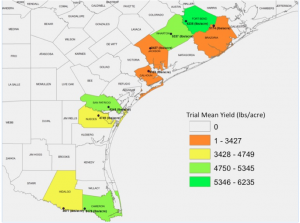
2015 Texas A&M AgriLife Extension county replicated grain sorghum hybrid trials. Trial mean (lbs/acre) is shown.
In addition to county Extension trials, the Texas A&M AgriLife Research Crop Testing Program has results for grain sorghum hybrid trials at three locations posted at: http://varietytesting.tamu.edu/grainsorghum/. More locations will be available soon. These trials are small replicated plots with 25-45 commercial hybrids at each location. These trials provide an opportunity to compare performance of many new hybrids to current hybrids. Again, exercise caution when evaluating results at a single location. Consistency is the key when selecting top performing hybrids.
Harvest Aids in Grain Sorghum—A Review
This tip was provided by:
Calvin Trostle, Extension Agronomy, Lubbock, 806-746-6101, ctrostle@ag.tamu.edu
Statewide
Harvest Aids in Grain Sorghum—A Review
In the June 17 and July 1, 2014 (yes, a year ago) “Sorghum Tips” Dr. Ron Schnell and I discussed harvest aids in grain sorghum as well as desiccation. You can review that information at http://texassorghum.org/sorghum-tips/page/3 A 2003 Extension publication, “Harvest Aids in Sorghum” best accessed at http://publications.tamu.edu/CORN_SORGHUM/PUB_Harvest Aids in Sorghum.pdf, also discusses glyphosate and sodium chlorate and how they work in grain sorghum. We did not note in our above 2014 “Sorghum Tips” that Diquat 2L (Aceto) or RowRunner (Rotam), but not Reglone (Syngenta) (active ingredient is diquat dibromide), are labeled for seed hybrid grain sorghum production. Diquat acts similar to paraquat but is slightly less toxic (that is relative, still ‘skull-and-crossbones!), and it is used among other things on winter canola in Oklahoma.
Sodium chlorate a desiccant choice in fields with sugarcane aphid?
This product burns the leaves and will dry the head as well as the foliage whereas glyphosate may take up to a week to work, and it may not dry the head as much. This is our concern—sugarcane aphids looking for better quality forage for feeding might move or even be forced to the head. Sodium chlorate does not kill the plant, which could be a benefit if you have lodging concerns, but the product has its own safety concerns related to fire, and any sodium chlorate product should have a fire retardant in the chemical you buy. Sorghum will grow back, however, if not harvested in timely fashion after sodium chlorate treatment. If you use this chemical in a SCA-infested setting, I would like to hear of your experience.
A Short Update on Sugarcane Aphid in the Texas High Plains
Our Extension entomologists, farmers, etc. are reporting some odd observations. In spite of continued temperatures in the low 90’s and 65-70°F at night—conditions favorable for continued SCA development, it appears that in some fields SCA numbers are decreasing, and we have received reports where farmers believe there may be less than half of SCA numbers from just a week or 10 days ago. Likewise, a few surprises arise. For example, a farmer in Yoakum Co. with several thousand acres of grain sorghum, some planted as early as late April, other acres planted in June, has not sprayed a single acre as he never saw a major issue. Though he might have hit the technical thresholds, his fields (many different hybrids) never developed excessive numbers of SCA. He didn’t spray and it appears he will be OK. I will be visiting another field in Crosby Co. Friday where a farmer has had to spray four circles for serious SCA issues, but another adjacent hybrid has far fewer SCA, and he has not sprayed it. Wow! This is interesting. I will scout the field, record SCA numbers, etc.
Ladybugs like about all of us have never seen!…
I was in a field northeast of Lubbock on August 27 where aphids commonly ranged from 200 to 2,000 per leaf. I saw as many as 38 lady beetle adults on a single leaf, as many as four lady beetle larvae and 12 or more adults within a single head. This field had few winged adults. On Monday, August 31, the farmer called to say that with a light 0.2” shower over the weekend and all these beneficials, it appeared that SCA numbers were greatly less. Another interesting situation. He was preparing to spray either Transform or Sivanto, but now will not. This is one reason why we are fortunate these two insecticides are not damaging to beneficials.
Still making insecticide sprays for sugarcane aphid?—Silicone additives
Bayer and DowAgro both now recommend a silicone based adjuvant/surfactant to improve coverage. Examples of a few commercial names include ‘Airforce’ and ‘Syl-tac’.
Threshold is Lowered for Triggering Sugarcane Aphid Sprays
This tip was provided by:
Calvin Trostle, Extension Agronomy, Lubbock, 806-746-6101, ctrostle@ag.tamu.edu
High Plains
Threshold is Lowered for Triggering Sugarcane Aphid Sprays
The following was published Friday, August 14, by Dr. Pat Porter, Extension entomologist, Lubbock. The full story is on the main page at http://txscan.blogspot.com/ (scroll down for August 14).
“Now that we have had a few weeks of experience with field-scale sugarcane aphid control in the southern High Plains, it appears we need to move to a more conservative treatment threshold than the one currently in use. What we are finding in commercial fields and our insecticide trial is that our insecticides do not seem to be working quite as well as they do in more southern locations with higher humidity and less intense sunlight. Whether our environment affects the insects, plants and/or insecticides differently is unknown, and what we are seeing could be a combination of all three factors – or two or one or none, we just don’t know. Insecticide coverage issues may also be in play. We could be experiencing insecticide interception by excessive honeydew such that some of the insecticide never gets to the leaf surface. We also do not know the importance of reduction in coverage and canopy penetration attributable to aerial application rather than ground application with higher volumes of water. Additionally, we also have reports of narrow row fields (less than 36 inches) having reduced insecticide efficacy, and this of course is a coverage issue.
The preceding paragraph is basically to say that we are not sure what is causing reduced control. We want to make it absolutely clear that there is no reason to think this is a resistance issue. However, with regard to application timing the prudent thing to do is to initiate insecticide applications sooner, before the aphids reach 50-125 aphids per leaf. For that reason we are recommending the action thresholds in use in Mississippi.”
** ** **
Consult the above URL for the full report. Thresholds have been changed from 50-125 average aphids per plant to a percent infested plants (20% or 30% depending on growth stage). Furthermore, some additives may be considered to potentially enhance insecticide effectiveness. I have also heard reports of suggestions to increase insecticide rates (now possibly 1.5 oz/A for Transform, up from 1.0; and 5.0 oz./A for Sivanto, up from 4.0). Do not overlook the importance of coverage—which requires higher gallonage, closer spraying to the target (airplanes flying too high?), etc. –Calvin Trostle
Being Practical—and Correctly Informed—about Sugarcane Aphid
High Plains & Rolling Plains
High Plains growers are getting their first ‘real’ taste of sugarcane aphid (SCA). It isn’t sweet. It is ironic that High Plains growers might have more issues in 2015 than did most Central & South Texas growers where SCA had to deal with a lot of cool, rainy weather, which seems to suppress the aphid, allow beneficials to keep it in check, etc. Dr. Ron Schnell (College Station) and Dr. Josh McGinty (Corpus Christi), others report that at most 10%, maybe 15% of acres in their areas were sprayed for SCA.
Where will we be in the High Plains? Especially since SCA was first reported here up to two months sooner than 2014.
As of August 5 a few thousand acres in the High Plains have been sprayed for SCA. I am not sure that all of these were the right acres. Indications, including comments from regional IPM agents, are that some acres were sprayed below threshold (misinformation, lack of proper scouting, poor recommendations from private scouts?), and some acres need spraying but haven’t been. Premature spraying is not a good idea as 1) you perhaps use some of your allotted insecticides sprays (especially Transform, which you can only spray twice), and 2) it is possible that you actually might not reach threshold.
I urge all—producers, scouts, chemical dealers—in your area: be aware of SCA. There does appear to be some misinformation regarding SCA in the High Plains. All High Plains and Rolling Plains fields should be scouted at least weekly to identify the Presence of SCA. Here are two cases that highlight what can happen or what some producers might have in mind (nonchalance?):
- Producer on Lynn-Dawson border: He knew SCA was in the area (Presence), but since he planted a so-called ‘tolerant’ hybrid in early (mid-May) in the cropping season (a good strategy), he wasn’t too worried about things, or at least hadn’t gotten to follow-up on a couple of his own fields that he found some aphids about July 13. He did not check fields again until Wednesday, July 29, in late bloom (16-day gap), and the SCA’s were so bad that he actually wondered if he could save his field (he can). He sprayed 1,100 acres, all at or above threshold (50-125 aphids per leaf). This grower has other fields about 10 miles to the west that are a different purported tolerant hybrid, and though he hasn’t yet seen aphids there, he sure needs to check at least once per week, then go to two 2X/week once the initial presence is confirmed. What if you were this farmer’s neighbor and you have grain sorghum?—Do you need to spray? No, scout first!
- August 3 I made a field visit to a producer at Wilson, Lynn Co., to assess another issue in grain sorghum. I asked the farmer if he was checking any for SCA on his grain sorghum. “Some.” He knows a few farmers are spraying, he has heard it is worse in one company’s hybrids (I don’t think so; no one brand is more susceptible than others—all hybrids, even those designated as ‘tolerant’ are still susceptible to SCA, e.g. the first grower above). After we finished, I looked at two of his fields, and a neighbor’s across the road. SCA on about 10% of plants. Needs to be scouted every 3-4 days.
Kerry Siders, Hockley/Cochran/Parmer Co. IPM agent, k-siders@tamu.edu, (806) 894-3150, is in the midst of ten Extension meetings on SCA. Kerry noted August 4th that fields are highly variable with SCA, and he has yet to report a field in his service area that has reached the threshold for spaying. But a few of his growers have been told by scouts they have SCA (threshold or not) and told to “spray it all.” Whoa! That was bad advice. Kerry told his producer to ask the scout for the field SCA counts to verify what levels of SCA were in the field. Also, Kerry advised that you CAN NOT adequately evaluate SCA on field edges—you will have to walk the field. In one case he walked several hundred feet into the field, found a major hot spot with several plants with 1,000 or more SCA per leaf, but then in all directions from this hot spot couldn’t find ANY more SCA! Just as we would not want to spray a field at threshold SCA (or worse) late; likewise, we do not want to spray a field early. Field results will be variable. Hot weather fires off SCA, but cloudy, cool days like Saturday, August 1, in the South Plains can suppresses SCA growth according to Siders. Siders did note, however, that SCA is with us to the end of the season in the High Plains. Growers that planted early, knowing that SCA might be an issue, are probably glad they did so (this is similar to how we would manage for sorghum midge, by the way).
A special note for the Texas Panhandle — Common current aphids are not SCA: Several SCA reports from the east and northeast Texas Panhandle proved to be not SCA but yellow sugarcane aphid (these are distinctly different). Yellow sugarcane aphids can be a damaging pest, but it is managed differently than SCA. For information on this insect review the Texas grain sorghum insect and pest guide (Extension publication E-1220) online here.
Sugarcane Aphid Resources—Summary & Key Documents, including “Scout Card”
This is a summary of key documents that entail numerous aspects of sugarcane aphid (SCA) biology, scouting, control options, etc. The documents listed below are found across four AgriLife websites so this will bring these to one location for your convenience.*Click the colored title to be directed to the website.
1) Sugarcane Aphid Management Guide, e.g. “The Sugarcane Aphid: A New Pest of Grain and Forage Sorghum” (April 25, 2015). Comprehensive guide to SCA in Texas grain sorghum.
2) Sugarcane Aphid Newsletter, e.g. Crop Management Newsletter 23:6, (July 1, 2015). A good Dawson-Lynn summary from Tommy Doederlein on expectations with the earlier arrival of SCA in the South Plains (initial confirmation late June 2015 relative to 2014 (identified about 2 months sooner this year).
3) Sugarcane Aphid Scouting School PowerPoint, (early 2015?). Summary of tips including specifics regarding labeled SCA insecticides Transform and Sivanto.
4) Recognizing the Sugarcane Aphid, (February 27, 2015). How to distinguish SCA from greenbug, corn leaf aphid, and especially the yellow sugarcane aphid (a different pest, which is currently prevalent in Texas Panhandle grain sorghum, late July 2015). You will need a good magnifying glass (and your reading glasses if you use them) to simplify aphid identification.
5) Sugarcane Aphid Field Scout Card, (April 2015). You can use this in the field to guide scouting, estimate SCA infestations and aphid numbers, etc. (approximate numbers without actually counting to comparable reference pictures).
6) Insecticide Selection for Sorghum at Risk to Sugarcane Aphid Infestations, (April 2015). The labeled and common pyrethroid insecticides for other common grain sorghum insects reduce beneficial insect populations thus enhancing potential increases in SCA. Options are discussed.
Updated News and Blog Post Notifications
High Pains growers, it is not too late to sign up on the right side of the page at http://txscan.blogspot.com/ to receive regular SCA news and blog update notifications to your e-mail.
Upcoming Texas A&M AgriLife Extension SCA Meetings in the High Plains
Friday, August 7
Brownfield – Terry County Extension Office – 8:30 am
Monday, August 10
Morton – Cochran County Activity Room, Cochran Co. Extension Office – 8:30 am
